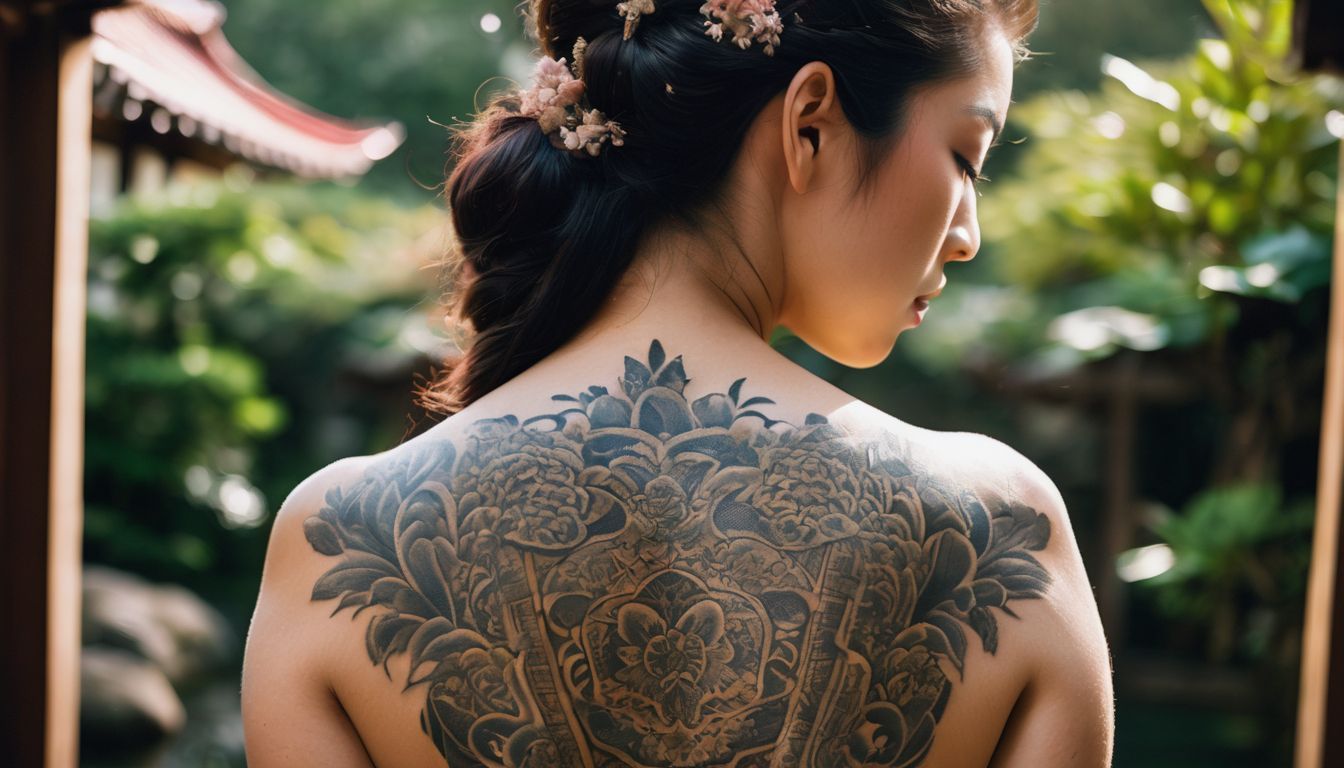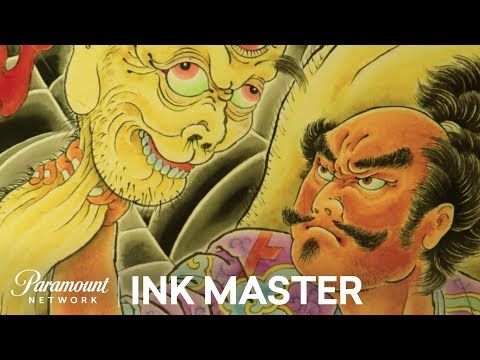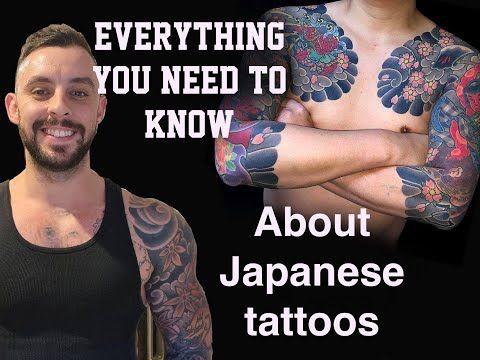Exploring the Art of Japanese Style Tattoos: Meanings and Symbolism
Many people want to ink their skin with tattoos that tell a story or hold deep meaning. Japanese style tattoos, known for their rich history and symbolic images, offer just that kind of depth.
This article will dive into the world of Irezumi, exploring its traditional symbols and modern twists to help you understand the art behind these stunning designs. Keep reading to unlock the secrets behind each stroke and shade!
Key Takeaways
- Japanese tattoos, or Irezumi, have a centuries – old history filled with rich symbolism and cultural significance, often representing stories or personal beliefs.
- Traditional symbols like dragons represent wisdom and strength; koi fish symbolize perseverance; cherry blossoms express life’s fragility; while skulls reflect on mortality within Japanese tattoo designs.
- Techniques such as Tabori hand-poking showcase craftsmanship while modern styles like Neo-Japanese and Realism introduce innovative approaches to this ancient art form.
- Japanese Tattoo Culture involves rites of passage, respected apprenticeships for artists in training, specific etiquette during tattoo sessions, and contributions from prominent Japanese tattoo artists making an impact globally.
- When designing a Japanese style tattoo, it’s crucial to tell a story that is personalized through traditional motifs adapted to the body’s natural contours using high contrast for longevity.
History and Culture of Japanese Tattoos
Japanese tattoos have a rich history and cultural significance, with traditional Japanese tattoos (Irezumi) dating back centuries. Today, contemporary Japanese tattoos continue to evolve as an art form, drawing inspiration from the country’s deep-rooted artistic traditions.
Traditional Japanese Tattoos (Irezumi)
Traditional Japanese tattoos, known as Irezumi, have a rich history that dates back to the Edo period. Skilled artisans create these complex designs by hand, inserting ink beneath the skin’s surface with unique tools.
Each design carries deep symbolism and often tells a story or represents the wearer’s beliefs or aspirations.
The process of getting an Irezumi is rigorous and steeped in tradition. Symbols like koi fish, dragons, tigers, and cherry blossoms are prevalent in traditional Japanese tattoo art, each carrying its own set of meanings tied to cultural folklore and values.
The full-body suits or sleeves can take years to complete due to their intricate detail and the significant amount of time required for healing between sessions.
Contemporary Japanese Tattoos
Contemporary Japanese tattoos have evolved from traditional Irezumi to incorporate modern styles and techniques. Today, tattoo artists in Japan are influenced by global trends, infusing traditional motifs with new artistic elements.
Wabori, a hand-poke technique used for centuries, has made a resurgence along with neo-Japanese and realism styles. Many contemporary Japanese tattoos now feature a blend of traditional characters and mythology combined with natural elements like waves or sakura blossoms.
Japanese tattoo culture continues to adapt as more people embrace body art in Japan. With this shift, young Japanese artists are gaining recognition worldwide while also preserving the rich heritage of Japanese tattooing.
Symbolism and Meanings in Japanese Tattoo Designs
Explore the intricate symbolism and meanings behind traditional Japanese tattoo designs, such as dragons, tigers, koi fish, cherry blossoms, skulls, and hannya masks. Each element carries its own significance and adds depth to the overall storytelling of the tattoo.
Dragon
The dragon is a popular motif in Japanese tattoos, symbolizing wisdom, strength, and protection. It often represents the balance between power and benevolence. In traditional Japanese tattoo art, the dragon is depicted with fierce eyes, sharp claws, and powerful scales to convey its untamed nature.
The imagery of dragons intertwining with clouds or waves can emphasize their association with natural elements and spiritual forces.
In contemporary Japanese tattoos, artists may interpret the dragon in various styles such as neo-traditional or realism while still honoring its symbolic significance. When choosing a dragon design for a tattoo, it’s essential to consider its placement on the body as well as color symbolism associated with different hues of dragons such as red for passion or green for life and renewal.
Tiger
Moving from the symbolism of the dragon to that of the tiger, the tiger holds a significant place in Japanese tattoo designs. The tiger is often associated with strength, courage, and protection.
In Japanese folklore and mythology, tigers are seen as powerful creatures that ward off evil spirits and bring good luck. As a symbol of bravery and ferocity, tiger tattoos can represent overcoming obstacles or facing challenges with courage.
Tiger tattoos often feature bold lines and vibrant colors to capture the animal’s energy and power. They are commonly depicted in fierce poses or surrounded by traditional Japanese elements such as clouds or waves to enhance their symbolic meaning.
Koi
The koi fish holds deep significance in Japanese tattoo culture. Its symbolism is associated with strength, determination, and the ability to overcome adversity. The vibrant colors and flowing movement of the koi make it a popular choice for tattoo designs, often depicted swimming upstream or leaping over waterfalls.
In Japanese folklore, the koi represents perseverance and transformation, as it is believed to transform into a dragon after successfully climbing the “Dragon’s Gate.” Whether portrayed alone or alongside other elements like waves or lotus flowers, Koi tattoos convey powerful messages of resilience and success.
Koi fish tattoos are not just visually striking; they also carry profound meaning rooted in Japanese mythology and cultural beliefs. From its mesmerizing appearance to its rich symbolism, the koi continues to inspire captivating tattoo designs that resonate with individuals seeking personal strength and courage.
Cherry Blossom
Cherry blossom, known as sakura in Japan, symbolizes the fleeting nature of life and its beauty. This delicate flower holds deep cultural significance in Japanese art and tattoos. In traditional Japanese tattoo designs, cherry blossoms are often used to represent the transience of life and mortality.
They are commonly depicted alongside other symbols such as koi fish or dragons to convey a profound message of living in the present moment and embracing change.
Amidst the intricate world of Japanese tattoos, cherry blossoms stand out as a timeless motif that captivates not only for their aesthetic appeal but also for their rich symbolism.
Skull
Skull motifs in Japanese tattoos often symbolize the concept of “memento mori,” representing mortality and the transient nature of life. In traditional Japanese tattooing, skulls are also associated with protection against evil spirits and bad luck.
These designs frequently incorporate other elements such as cherry blossoms or dragons to convey a deeper narrative, making them powerful symbols in Japanese tattoo art.
In contemporary Japanese tattoos, skull motifs can be seen in various styles ranging from traditional Irezumi to neo-Japanese and realism. Tattoo artists use bold lines and high contrast to create striking skull designs that capture the essence of this potent imagery.
Hannya Mask
The Hannya mask represents a tragic female figure in Japanese Noh theater. Its tattoo counterpart embodies jealousy, rage, and anguish. The intense expression and dramatic features capture the essence of this classic symbol.
Hannya masks are often incorporated into elaborate Japanese tattoo designs to convey complex emotions or evoke a sense of foreboding. Tattoo artists skillfully render the intricate details of the mask to bring out its haunting allure, making it a popular choice for those seeking to embrace the darker aspects of traditional Japanese artistry.
Techniques and Styles of Japanese Tattoos
Tabori “Hand Tattooing” is a traditional Japanese technique, while Neo-Japanese and Realism are contemporary styles to consider. Traditional Japanese characters and mythology, as well as natural elements like waves and flowers, also play a significant role in the art of Japanese tattoos.
Tabori “Hand Tattooing”
Tabori, also known as tebori, is a traditional Japanese hand tattooing technique that dates back centuries. This method involves using a handheld rod with needles attached to the tip, which are then manually applied to the skin by skilled artisans.
The tebori process allows for greater control and precision, resulting in intricate and detailed designs. This ancient technique is highly respected within the tattoo community and reflects the deep-rooted tradition of craftsmanship in Japanese culture.
Artists who specialize in Tabori undergo rigorous training and apprenticeships to perfect their skills. The process requires both technical proficiency and an understanding of traditional Japanese motifs and symbolism, making it a revered art form among enthusiasts.
Neo-Japanese
Contemporary Japanese tattoo artists have started to blend traditional motifs with modern techniques, creating a style known as “Neo-Japanese.” This style retains the classic themes of Japanese tattoos but incorporates more vibrant colors and softer lines.
Neo-Japanese tattoos often feature a fusion of traditional elements such as dragons, cherry blossoms, and koi fish with Western influences like realism and illustrative styles. This unique combination results in striking designs that showcase both the rich history of Japanese tattooing and the innovation of contemporary artistry.
The Neo-Japanese style continues to evolve, inspiring new trends and captivating tattoo enthusiasts worldwide. Modern artists are pushing boundaries by experimenting with different color palettes and incorporating diverse cultural symbols into their designs, further enriching the storytelling aspect of Japanese tattoos.
Realism
Realism in Japanese tattoo art aims to create designs that closely resemble real-life objects or scenes. This style often showcases intricate details and shading techniques, giving tattoos a lifelike appearance.
Artists use precise line work and expert shading to bring depth and dimension to their creations, resulting in stunningly realistic images that captivate the eye. Realism allows for a wide range of subject matter, from portraits of loved ones to natural elements such as flowers and animals, making it a versatile choice for those seeking highly detailed and true-to-life tattoos.
Moving on from realism, let’s delve into the traditional Japanese characters and mythology found in Japanese tattoo art.
Traditional Japanese Characters and Mythology
Japanese tattoo art frequently incorporates traditional characters and mythology, such as samurai, geisha, and folklore figures like dragons and yokai. These iconic images convey deep cultural significance while adding layers of meaning to the wearer’s story.
The heroic values associated with historical figures like Miyamoto Musashi or mythical creatures such as the kitsune (fox) reflect bravery, wisdom, resilience, and cunning philosophies embedded in Japanese ethos.
Samurai embody honor and loyalty; geishas symbolize grace and beauty. These timeless characters blend seamlessly with Japanese tattoo aesthetics, infusing designs with compelling narrative elements that captivate both wearers and admirers.
In addition to these narratives of courage and beauty from Japan’s history are mythological beasts richly intertwined within traditional tattoos. Dragons represent strength, power, and good fortune; koi fish symbolize determination against adversity; cherry blossoms signify ephemeral beauty amidst life’s transience; hannya masks show transformation from rage into enlightenment.
Natural Elements
Transitioning from traditional Japanese characters and mythology to natural elements, it’s important to recognize the significance of nature in Japanese tattoo design. Natural elements such as water, fire, wind, and earth play a vital role in Japanese tattoos.
These elements are often depicted with their associated symbolism – water represents strength and tranquility; fire symbolizes passion and transformation; wind signifies freedom and change; while earth embodies stability and grounding.
Incorporating these natural symbols into Japanese tattoo designs adds depth and meaning to the artwork, allowing individuals to express their connection with the environment and its powerful forces.
The portrayal of natural elements in Japanese tattoos reflects an admiration for nature’s beauty and resilience. The use of flowing water or roaring flames can convey emotions like determination or rebirth, connecting the wearer with fundamental aspects of existence.
Japanese Tattoo Culture
Japanese Tattoo Culture encompasses various aspects such as rites of passage, the process of becoming a tattoo artist through apprenticeships, the etiquette surrounding tattoos in Japan, and the prominent Japanese tattoo artists making a mark in the industry.
Rites of Passage
In Japanese culture, getting a traditional tattoo is often considered a rite of passage for individuals reaching adulthood. For many, this ancient practice symbolizes the transition into maturity and often signifies a deep connection to one’s cultural heritage.
Tattooing has historically played an integral role in various ceremonies and rituals, marking important milestones in an individual’s life. These tattoos are not only symbols of artistic expression but also serve as physical markers of personal growth and societal acceptance.
As part of the Japanese tattoo tradition, undergoing the process of receiving intricate irezumi designs is seen as a transformative experience that holds significant spiritual and cultural meaning.
Tattoo Artists and Apprenticeships
Transitioning from the traditional rite of passage to becoming a tattoo artist, apprenticeships play a crucial role in preserving the art form’s heritage and techniques. Apprenticeships are an integral part of the Japanese tattoo culture, where aspiring artists devote themselves to learning under a master tattooist.
By doing so, they gain invaluable hands-on experience and insight into the deep symbolism and technical skills required for creating authentic Japanese tattoos.
During their apprenticeships, individuals absorb not only the artistic aspects but also important cultural etiquette and respect for clients. This immersive training ensures that future Japanese tattoo artists uphold the traditions and symbolism embedded within this revered art form while cultivating their unique style and creativity.
Tattoo Etiquette
Respect the tattoo artist’s craft and time by arriving punctually for your appointment. Communicate openly and clearly about your design ideas, placement preferences, and any concerns or questions you may have.
Keep in mind that some tattoo studios may have specific etiquette rules regarding noise levels, bringing guests, or using mobile devices during the session.
Maintain proper aftercare of your tattoo as per the artist’s instructions to ensure optimal healing and long-term preservation of the artwork. Avoid asking personal questions about the artist’s tattoos unless they willingly share information with you.
Prominent Japanese Tattoo Artists
Tattoo Etiquette is important, and so are the artists who have made a mark in Japanese tattooing. Here are some of the most renowned Japanese tattoo artists:
- Horiyoshi III – Known for his mastery of traditional Japanese tattooing (Irezumi) and intricate full body suits.
- Shige – Recognized for his fusion of traditional Japanese motifs with modern techniques and themes, such as bio-organic designs.
- Horitomo – Specializes in creating stunning imagery based on traditional Japanese folklore, often blending it with Western influences.
- Gakkin – Renowned for his contemporary approach to Irezumi, integrating geometric patterns and abstract designs into his work.
- Hori Taka – Embraces the Neo-Japanese style by infusing bold colors, detailed linework, and a mix of old and new subject matter.
Tips for Creating Your Own Japanese Tattoo Design
Tell a captivating story through your design, considering traditional Japanese motifs and symbolism. Work with the natural flow of the body to create a harmonious composition, using high contrast and bold line work to make your tattoo stand out.
Incorporate color symbolism for added depth and meaning, and if you’re inspired, consider pursuing a career in tattooing.
Tell a Story
Crafting a Japanese tattoo design is an opportunity to tell a personal story through the fusion of traditional motifs and modern aesthetics. Incorporate symbols that hold significance for you, whether it’s the resilience of a cherry blossom or the strength of a dragon.
By weaving these elements together in a cohesive narrative, your tattoo becomes a visual tale that reflects your values, experiences, and aspirations. Embrace the artistry behind each symbol while considering how they intertwine to form a compelling story on your skin.
Immerse yourself in the cultural richness and symbolism embedded within Japanese tattoos as you embark on creating your own design. The process begins with reflecting on your unique journey and finding ways to translate it into meaningful imagery.
Work with the Body’s Flow
When creating a Japanese tattoo design, it’s essential to work with the body’s natural flow. This involves considering the body’s contours and movements to ensure that the tattoo complements and enhances the natural lines of the body.
By understanding how the design will wrap around muscles, bones, or curves, a skilled artist can create a harmonious and visually appealing tattoo that flows with the body rather than working against it.
To achieve this, artists carefully study anatomy and use their knowledge to craft designs that seamlessly integrate with the client’s physique. This approach allows for a more organic and personalized tattoo that not only looks aesthetically pleasing but also respects the natural form of the individual.
Use High Contrast and Bold Line Work
When creating a Japanese tattoo design, it is essential to use high contrast and bold line work. These elements help the tattoo maintain its clarity and strength over time, ensuring that the intricate details of traditional Japanese motifs such as dragons, tigers, or cherry blossoms remain visually striking.
The high contrast also allows for better definition and visibility of the symbolic elements within the design, making it more impactful and aesthetically pleasing. Bold line work serves to outline the shapes and forms within the tattoo, providing a sense of structure and enhancing the overall visual impact of the art.
By incorporating high contrast and bold line work into a Japanese tattoo design, artists can effectively capture the essence of traditional motifs while ensuring longevity and visual appeal.
Consider Color Symbolism
When designing a Japanese tattoo, color symbolism plays a crucial role in conveying meaning and emotion. Each color holds significance in Japanese culture, with red representing passion and energy, black symbolizing strength and formality, and blue signifying tranquility and calmness.
Incorporating these colors thoughtfully into the design can enhance the overall symbolism of the tattoo, effectively communicating the intended message to the viewer. Additionally, understanding how different hues are perceived in Japanese tradition can help create a more impactful and culturally significant tattoo design.
In Japanese tattoos, color symbolism is deeply rooted in cultural traditions and beliefs. By carefully selecting colors that hold specific meanings within Japanese culture, individuals can infuse their tattoos with deeper layers of symbolism and personal significance.
Prepare for a Tattooing Career
Entering the world of tattooing requires dedication, passion, and a willingness to learn from experienced artists. Preparing for a career in tattooing involves seeking out reputable apprenticeships, studying different techniques and styles, practicing art consistently to improve skills, understanding proper hygiene and safety protocols, as well as developing a portfolio that showcases artistic versatility.
Additionally, building a strong online presence through social media is crucial for networking within the industry and gaining exposure to potential clients. It’s also essential to research local regulations and legal requirements regarding tattooing practices.
Gaining insight into successful Japanese tattoo artists can provide valuable inspiration and guidance for aspiring professionals looking to specialize in this unique style. Understanding their journeys can offer significant motivation and perspective on the hard work required to thrive in the competitive field of Japanese tattoo artistry.
Conclusion
In conclusion, Japanese style tattoos carry profound meanings rooted in rich cultural traditions. These tattoos feature iconic symbols such as dragons, koi fish, and cherry blossoms, each representing unique virtues and concepts.
The art of Japanese tattooing continues to evolve, blending traditional techniques with modern styles to create captivating designs. Understanding the symbolism behind these tattoos adds depth and significance to this timeless art form.
Aspiring enthusiasts can draw inspiration from the intricate history and symbolic language of Japanese tattooing to craft their own meaningful designs.
FAQs
1. What are Japanese traditional tattoos?
Japanese traditional tattoos, known as Irezumi or Harimono, are a form of body art with rich symbolism and history behind each design.
2. Can you explain the meanings behind Japanese tattoo symbols?
Sure! Symbols in Japanese tattoos have deep meanings; for example, a Koi fish tattoo commonly represents strength and determination because these creatures swim upstream.
3. Are there specific rules for Traditional Japanese tattoo placement?
Yes, there are traditional rules that guide the placement of Japanese tattoos on the body to ensure they align with cultural values and Irezumi symbolism.
4. What kind of designs can I find in a Japanese tattoo sleeve?
A typical Japanese tattoo sleeve might include motifs like cherry blossoms for life’s fleeting nature or dragons symbolizing wisdom and power.
5. How does symbolism play a role in the artistry of Japanese tattoos?
Symbolism is key in the artistry of these pieces; it conveys stories, virtues and honors both personal accomplishments and cultural narratives through intricate, meaningful designs.










